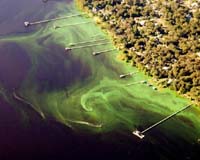| . |  |
. |
West Lafayette IN (SPX) Aug 20, 2010 Controlling urban growth and increasing forested land are the most effective ways to decrease future water runoff and flooding, according to a Purdue University study. Bryan Pijanowski, an associate professor of forestry and natural resources, used a model to simulate Michigan's Muskegon River watershed runoff rates from 1900 through the present and forecast them 30 years into the future. Several scenarios, including forest regrowth, urbanization, and buffers between development and streams, were analyzed to estimate their impact on rivers and streams. "Changes in the land's surface feed back to runoff. Urban sprawl and impervious surfaces are the biggest culprits," Pijanowski said. "If you're able to control development, it is the most effective way to save our river ecosystem." Pijanowski said urban areas in the United States would double in 20 years at the current rate. In the model predictions, doubling the urban area in the Muskegon River watershed would increase runoff by 1 1/2 times. Excess runoff can have several consequences, including flooding, increases in agricultural nutrients and urban pollutants entering nearby water and affecting aquatic life, increases in water temperature in rivers and streams that can affect aquatic life, and changes in the apportionment of water to wetlands and groundwater. Pijanowski's findings, published in the early online version of the journal Environmental Management, suggest that slowing the rate of urban sprawl would be the most effective way to reduce or control runoff. Adding forest near rivers and streams and requiring buffer zones between those waterways and development also could help. Pijanowski used historical data - including census information, aerial photos and housing statistics - to build historical landscapes back to the early 1900s. That data was fed into the Land Transformation Model, developed at Purdue, to determine historical runoff rates. Predictions from the present through 2030 also were created using the model. Assumptions for those predictions were created by local governments, state agencies and non-governmental groups working around the Muskegon River based on their knowledge of development and other area trends. The findings included some good news: Pijanowski found that the landscape in the Midwest has improved since rapid deforestation in the late 1800s and early 1900s, with the best balance of urban and forested land since then occurring in the 1960s. Rebuilding efforts after the Great Chicago Fire of 1871 caused heavy deforestation. But the federal government reforested farmland that it took possession of in the Great Depression, leading to the balance observed in the 1960s. "The past is the worst we'll ever see over a 140-year period. Even the worst-case scenarios show that the landscape won't be as bad as what we had in the 1890s and early 1900s," Pijanowski said. "The lesson here is that with time and care, these systems can be restored. Recovery is possible." Pijanowski's future work will include examining the role landscape changes play in climate change and determining tipping points at which landscape changes impact rivers and streams. The National Science Foundation, NASA and the Great Lakes Fishery Trust funded the research.
Share This Article With Planet Earth
Related Links National Science Foundation Water News - Science, Technology and Politics
 How Algae 'Enslavement' Threatens Freshwater Bodies
How Algae 'Enslavement' Threatens Freshwater BodiesJerusalem, Israel (SPX) Aug 19, 2010 How toxic, blue-green algae out-compete other organisms through a form of selfish "enslavement" - and by so doing proliferate dangerously in freshwater bodies - has been described by a researcher at the Hebrew University of Jerusalem. In general, the increasing occurrence of toxic cyanobacterial (blue-green algae) blooms in freshwater bodies is a matter of growing international concern due ... read more |
|
| The content herein, unless otherwise known to be public domain, are Copyright 1995-2010 - SpaceDaily. AFP and UPI Wire Stories are copyright Agence France-Presse and United Press International. ESA Portal Reports are copyright European Space Agency. All NASA sourced material is public domain. Additional copyrights may apply in whole or part to other bona fide parties. Advertising does not imply endorsement,agreement or approval of any opinions, statements or information provided by SpaceDaily on any Web page published or hosted by SpaceDaily. Privacy Statement |